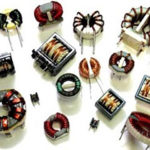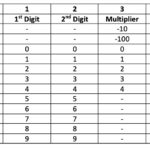In the previous article, we discussed the fundamentals and working principles of an inductor. We also learned about some common types of inductors like solenoidal coils, toroids, pot cores e and transmission line inductors. Inductors come in a variety of many other types based on construction. When select selecting an inductor for a given circuit, it is important to understand their various specifications and non-ideal characteristics.
These electrical specifications remain common among all types of inductors. Different types of inductors are just application or circuit-specific constructions. Unlike capacitors or resistors, it is relatively easy to select a type of inductor for a given application. The different types of capacitors and resistors have somewhat overlapping application areas. As discussed in previous articles, several factors account for their selection.
The different electrical specifications are useful in determining the role and efficiency of an inductor for a given circuit or application rather than the selection of a type or specific inductor. The key technical specifications associated with inductors are as follows:
Nominal Inductance – The first specification that needs to be considered is an inductor’s nominal inductance — or the value of inductance that the inductor is supposed to offer at a particular frequency and voltage. Nominal inductance is generally expressed in Microhenry, Millihenry, or Henry. Generally, engineers are either supplied the value of required inductance in the datasheet when using with an IC or in case of analog circuits; or they need to derive the value of required inductance as per the application or circuit. For instance, an engineer might need to derive the value of the necessary inductance for a filter circuit. The inductance of an inductor depends upon the material used as the core, shape of the core, number of turns of coil, shape, and size of the inductor.
Tolerance – Inductance like capacitance is a dynamic property. It can change with the frequency of the signal, temperature, and current. It is, therefore, always important to consider the inductive tolerance of an inductor. The tolerance is the maximum variation in the value of inductance under all possible test conditions. Ideally, the inductance should not vary beyond the indicated tolerance under any condition or else it may be damaged due to inappropriate use or application. The inductors can have +/-1%, +/-2%, +/-3%, +/-5%, +/-10%, +/-15%, or +/-20% tolerance. The tolerance is indicated by the following letters:
Saturation Current – As already discussed, the inductors using ferromagnetic cores beyond a critical current level show a drop in inductance. This current level is indicated as Saturation Current. The drop in inductance can be up to ten percent in inductors designed using ferrite cores and up to 20 percent in inductors using powered iron as the core. This drop in inductance is the result of the limitation of core material to store a certain maximum amount of magnetic flux. The current-carrying ability of an inductor depends on the thickness of the coil, and any coil may allow current beyond the saturation level. A large current beyond saturation current can damage or fracture an inductor’s core so it is essential to note the saturation current rating of an inductor. The saturation current of a selected inductor should be at least 1.5 times the maximum current that inductor may be exposed to in the circuit. It is important to take into account any pulsating currents when choosing a saturation current level, as well as to examine how inductance is varying with the current to ensure efficient and expected operation of the inductor in a circuit.
Curie Temperature – As the current increases beyond the saturation level, the core of the inductors heats up. It can get damaged or fractured, leading to loss of its magnetic properties when it gets hot enough. The temperature of the core beyond which the inductor loses its magnetic properties is called Curie Temperature. Once an inductor loss its magnetic properties, it remains nothing more than a connecting wire. It is important in the first place to maintain current levels below saturation current so that the inductor never heats up to its Curie temperature.
Ambient Temperature Range – This is the range of ambient temperature within which the inductor can operate without being damaged.
Operating Temperature Range – This is the range of temperature that an inductor can withstand without losing its magnetic properties or damaging itself. Usually, the higher temperature limit in the operating temperature range is the Curie temperature. The operating temperature range is always wider than the ambient temperature range because when current flow through an inductor, it is supposed to heat up compared to its ambient temperature.
Saturation Magnetic Flux Density (BSat) – This is the maximum flux density of the core of the inductor. This property is important in determining the maximum magnetic energy that an inductor can store at any time.
Maximum DC Current – This is the maximum level of direct current that can pass through the inductor without any damage. It is based on the maximum temperature (Curie temperature) an inductor can withstand at maximum ambient temperature. For low-frequency signals, it is directly comparable to maximum RMS current of the signal. For high-frequency signals, saturation current is a better benchmark.
Incremental Current – The DC current through the inductor that causes a drop in inductance by five percent as compared to inductance at the initial zero DC bias is called incremental current. Beyond this DC bias current level, the inductance starts dropping significantly. The rate at which inductance drops depends upon the ferromagnetic material of the core, as well as the shape of the inductor core. The drop in inductance remains linear for powdered iron cores while it drops at non-linear rates for ferrite cores.
Maximum DC Resistance – This is the maximum resistance offered by the coil of the inductor with DC current or the unwanted resistance of the inductor. In the design of an inductor, the maximum DC resistance should be minimized. This property always needs to be considered when determining the energy efficiency of an inductor in a given circuit.
Quality Factor (Q Factor) – Quality Factor (Q) is an indication of operating losses of the inductor. It is defined as the ratio of inductive reactance to the effective resistance. Both inductive reactance and effective resistance are functions of signal frequency. That is why the quality factor is always indicated in datasheets for a given test frequency. The higher the quality factor, the more energy-efficient is the inductor.
Self Resonant Frequency (SFR) – Due to turns of wire in inductor coil, there is always some distributed capacitance in inductors. This distributed capacitance is also a function of frequency. At a certain frequency, the capacitance and inductance of an inductor become equal, and they cancel each other. This is called Self Resonant Frequency (SFR). At this frequency, the inductor does not show any effect of inductance; instead, it behaves like high impedance pure resistance. At SFR, the quality factor of the inductor drops to zero. The distributed capacitance is modeled as a parallel capacitance to the pure inductance of the inductor. Beyond self-resonant frequency, the capacitive reactance due to the inductor coil dominates an inductor’s inductive reactance.
Inductance Temperature Coefficient – The Inductance Temperature Coefficient indicates the rate of change in the inductance of the inductor per unit centigrade. It is expressed in “Parts Per Million” change per Centigrade (PPM/°C). The temperature coefficient is generally positive until the inductor gets hot enough at saturation current. Beyond temperature at saturation current, the temperature coefficient becomes negative. The temperature coefficient remains linear for powdered iron cores, while it is generally non-linear and changes significantly for ferrite cores. In inductor datasheets, the change in inductance is indicated with respect to current rather than temperature, as the current is easily measurable compared to inductor temperature. Therefore, the graphical curve of “typical inductance versus current characteristics” should be examined in a datasheet for any effects of temperature on the inductance.
Resistance Temperature Coefficient – Like inductance, the DC resistance of the inductor also changes with temperature. However, this DC resistance will never exceed the maximum DC resistance specified for the inductor until the inductor gets damaged. Resistance Temperature Coefficient indicates the rate of change of DC resistance of the inductor. It is expressed in PPM/°C. As any wire always has a positive temperature coefficient, the resistance temperature coefficient is also always positive.
Electromagnetic Interference – The electromagnetic interference of an inductor refers to the magnetic field radiated out from the inductor. This can produce additive or subtractive mutual inductance with other inductors in the vicinity or may lead to unwanted interference to other magnetically sensitive components of the circuit. The electromagnetic interference can be useful when some mutual inductance is required in a circuit. Otherwise, in most of the cases, it is unwanted and may influence the selection of the inductor for a given design and PCB layout of a circuit.
Impedance – Impedance is the effective resistance of inductor to alternating current. It is the combination of DC resistance and the reactance (inductive reactance and distributed capacitive reactance) of the inductor. It is generally indicated by typical impedance characteristics graph in datasheets of the inductors. The graph is drawn between the impedance of the inductor and the signal frequency.
Activity 10
Try to figure out all the technical specifications we discussed in this inductor datasheet.
Check out online marketplaces for electrical and electronic components and review the different filters for selecting an inductor.
In the next article, we will discuss different types of inductors.
You may also like:
Filed Under: Tutorials









Questions related to this article?
👉Ask and discuss on Electro-Tech-Online.com and EDAboard.com forums.
Tell Us What You Think!!
You must be logged in to post a comment.